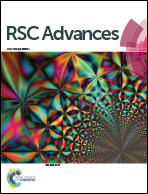Polyethylenimine as a dual functional additive for electron transporting layer in efficient solution processed planar heterojunction perovskite solar cells†
Abstract
We report a doping method to enhance the performance of solution processed planar heterojunction perovskite solar cells. By doping a small percentage (3 wt%) of polyethylenimine (PEI) as additive into the PCBM electron transport layer of an inverted perovskite solar cell, which led to significant enhancements of power conversion efficiency from (5.9 ± 0.2) % to (10.4 ± 0.2) %. The AFM images show that the PEI doped PCBM layer can help to form a high quality, homogeneous and compact electron transporting layer on the rough CH3NH3PbI3 layer, which results in enhanced hole blocking ability and reduced leakage current at the interfaces between the CH3NH3PbI3, PCBM films and the top Al electrode. Organic field-effect transistors (OFETs) measurements reveal that the addition of 1–3 wt% PEI into PCBM layer can improve device performance without any negative effect on the electron transport property of PCBM. Steady-state PL analysis shows that the electron-rich PEI may also act as an effective interfacial modifier to passivate the trap states at the perovskite surface or crystal boundaries and to avoid the undesired charge recombination often observed in perovskite solar cells. PEI will also improve performance as a cathode interfacial modifier because the PCE of the device with PEI deposited between PCBM and Al is superior to the device without PEI. This work demonstrated that amine-containing polymer materials can be used as an efficient dual functional additive in perovskite solar cells. This study provides an efficient way of developing highly efficient CH3NH3PbI3-based perovskite solar cells.


 Please wait while we load your content...
Please wait while we load your content...